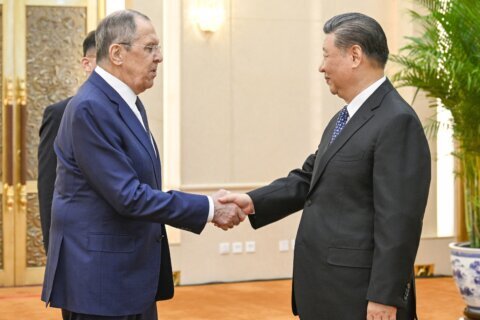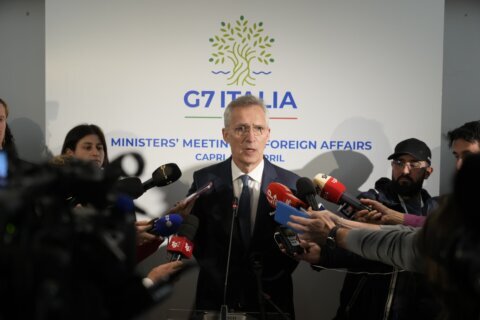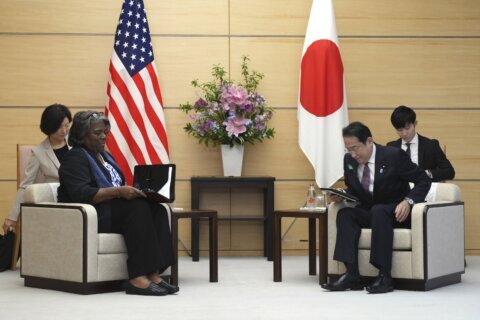KHERSON, Ukraine (AP) — When about 100 Russian troops rolled into Kherson’s Lilac Park on the morning of March 1, Oleh Shornik was one of about 20 lightly armed Ukrainian volunteers who didn’t stand a chance against them.
Ukraine’s military was nowhere to be seen, and Russian troops in armored vehicles had easily entered the Shumensky neighborhood, opening fire and sending shrapnel flying everywhere, witnesses said. Civilians walking to work were hit in the short, fierce battle. The volunteers, hiding among the trees in the park, were cut down so rapidly that they weren’t even able to throw the Molotov cocktails they had prepared.
“They did not have time to do anything,” said Anatolii Hudzenko, who was inside his home next to the park during the attack, in an interview with The Associated Press.
Left seemingly on their own, the civilian volunteers fell quickly. A day later, so did Kherson.
Thousands of Russian troops, sweeping up from the Crimean Peninsula on Feb. 24, captured the city on the Dnieper River so rapidly that many residents say they felt abandoned by the Ukrainian military and its quick withdrawal, leaving the city without an adequate defense.
But was the doomed stand in Lilac Park a futile, early act of resistance to what became a bloody Russian occupation of Kherson? Was it due to the hasty retreat by Ukraine’s military so it could regroup to fight another day — indeed later retaking the city in November? Or was it the result of a betrayal by high-level Ukrainian security officials collaborating with Moscow?
It’s possible it was a combination of all of those.
Now that Russia has retreated from Kherson following Ukraine’s counteroffensive in the south, residents want to know why Moscow’s forces were able to overrun the city so easily.
“There are more questions than answers to this story,” said Svetlana Shornik, standing at her ex-husband’s grave for the first time because the Russians had blocked access to the cemetery while they had occupied the city.
Besides the volunteers killed in the park, about five others were slain that day at a roundabout nearby.
Families of the dead say they have been trying in vain for months to get information from the military and the government so they can have some closure about the deaths of their loved ones.
“I know very little,” said Nadiia Khandusenko, recounting what few facts she knows about the death of her husband, Serhii, who also was killed in Lilac Park.
Wiping away tears, Shornik told the AP that she believes her ex-husband probably suffered in his final minutes because an autopsy revealed the 53-year-old retired policeman was shot in the lung. The bodies lay on the bloodstained grounds of the park for three days because the Russians would not allow them to be buried, residents said.
“They are heroes,” Shornik said. “They were practically defending (the city) with their bare hands,” she said.
___
Ukraine’s Territorial Defense Force began operating just before the Russian invasion. A volunteer militia under the command of the Defense Ministry, it was made up of civilians, part-time reservists and former troops to fight alongside the regular military.
Despite their lack of training and equipment, the volunteers have played a crucial role in the war and were a key reason Kyiv wasn’t occupied, said Mykhailo Samus, founder of New Geopolitics Research Network, a Ukrainian think tank.
“When a (Russian) sabotage group gets into a city, they expect to see civilians, but they found a lot of people with Kalashnikov guns and it was a disaster for Russians,” Samus said.
Civilian volunteers were unable to hold back the Russian forces from Kherson, a port city with a prewar population of 280,000 that is home to a ship-building industry.
Kherson is just north of Crimea, which Russia illegally annexed in 2014. When Ukraine controlled the city, it was able to cut off fresh water to the peninsula, and Russian President Vladimir Putin spoke of the need to restore water supplies as one reason to invade.
Flat and marshy, the Kherson region has few forests or other natural barriers to halt the tanks and troops from nearby Crimea that hosts Russia’s Black Sea fleet and air bases.
In addition, Ukrainian officials such as Kherson Mayor Ihor Kolykhaev told the newspaper Ukrainska Pravda in May that the failure to destroy key bridges leading to the Kherson and Zaporizhzhia regions was a mistake that helped the Russians, although he stressed he was not a military man.
Ukraine’s outnumbered military, meanwhile, had withdrawn from Kherson for the southern city of Mykolaiv, said Maj. Oleksandr Fedyunin, a military spokesman.
That withdrawal “ensured the survivability of troops and did not allow the enemy to gain fire superiority in the air,” said Bohdan Senyk, chief spokesman for the army.
Kherson’s swift capture has raised questions about whether Ukrainian collaborators aided the Russian invasion.
“Russia had its agents infiltrated into the Ukrainian security forces, and the cleanup by Kyiv was slow and inefficient,” said Orysia Lutsevych, head of the Ukraine forum at the London-based Chatham House think tank. “The cost of that betrayal was high human loss.”
On April 1, President Volodymyr Zelenskyy dismissed two senior officials of Ukraine’s SBU domestic security agency, including the head of the Kherson regional branch, stripping their rank as generals for violating their military oath of allegiance. He called them “anti-heroes” and said they “had trouble determining where their Fatherland is.”
He added: “I don’t have time now to deal with all the traitors, but they will all face punishment.”
In addition, an aide to one of those SBU officials was arrested and faces prosecution for allegedly handing over maps of minefields and helping coordinate Russian airstrikes that aided Moscow’s forces, said Oleksandr Samoilenko, head of Kherson’s regional legislature.
___
The Russian takeover of Kherson — the only regional capital to fall in the war — ushered in a harsh, eight-month occupation that saw fierce resistance from its remaining civilians, including attacks against Moscow-installed officials, planted bombs and other threats. Moscow introduced the ruble, set up Russian cellphone networks and cut off Ukrainian TV in the area. Street protests were banned.
As in other Ukrainian areas that Russia seized, officials who refused to cooperate were abducted, including the Kherson mayor, Kolykhaev. Residents allege they were confined, beaten, shocked, interrogated and threatened with death in at least five sites in the city and four others in the wider region.
The region was one of four that was illegally annexed by Moscow in September, although its troops were forced to withdraw weeks later as Ukrainians stepped up their attacks with U.S.-supplied missiles and cut the Russians’ supply lines. The retreating forces left behind mines and booby traps, shuttered shops and restaurants, and a traumatized population.
In Lilac Park, a small memorial honors the volunteers who fell there. Wreaths are fastened to a few trees, with some yellow roses and a plaque mounted with a cross and a small Ukrainian flag at the top.
It reads: “On March 1, 2022, fighters from the Territorial Defense were taken to heaven.”
___
Follow AP’s coverage of the war in Ukraine at https://apnews.com/hub/russia-ukraine
Copyright © 2024 The Associated Press. All rights reserved. This material may not be published, broadcast, written or redistributed.







